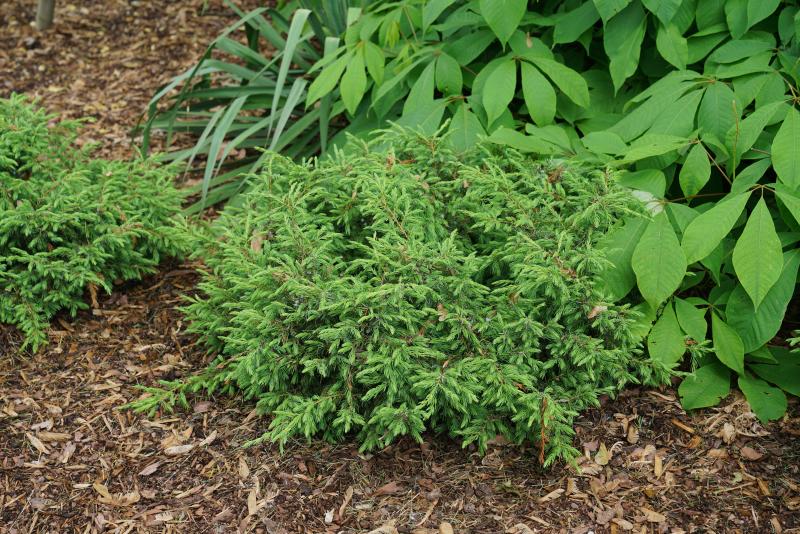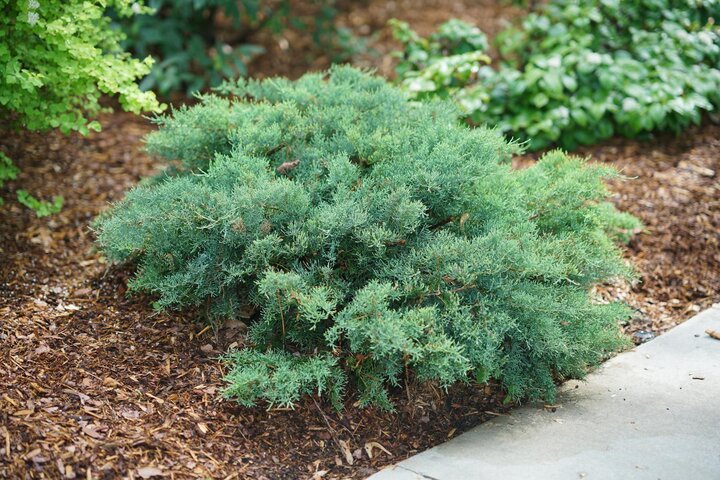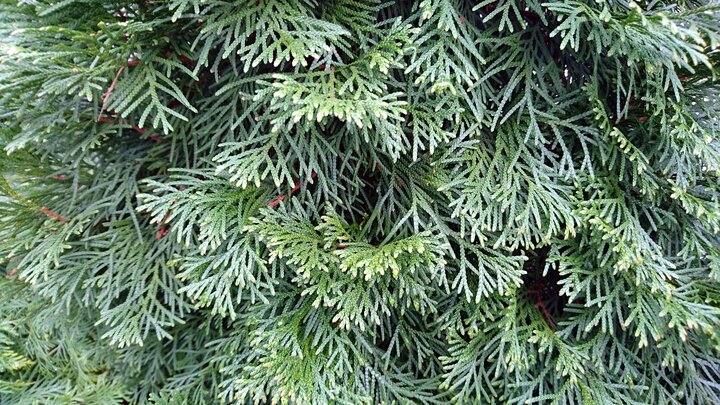Sarah Browning, Nebraska Extension Educator

'Tortuga' juniper. Image from Proven Winners, provenwinners.com.
Evergreens, both trees and shrubs, enliven the winter landscape, providing form, texture and color during a time when our landscapes are sparse. If your landscape is too bare and brown right now but you don't have room for a new tree, consider the addition of evergreen shrubs – there are many great options from which to choose.
Common evergreen shrub species used in Nebraska landscapes including yew, juniper, and arborvitae. Less common types include dwarf forms of pine, spruce and falsecypress.
Yew, Taxus spp., are high-quality adaptable shrubs with soft needles. They have a slow to medium growth rate, have few serious insect or disease problems and provide excellent year-round color. There is a good variety of forms and they even tolerate shaded conditions. Their one serious downfall is they are attractive to deer and often suffer deer browse when populations are high.
The most common types in Nebraska landscapes include Anglojap yew, Taxus x media, and Japanese yew, T. cuspidata. Many cultivars (cultivated varieties) of each species are available, and each specific cultivar will vary in its ultimate shape, size and growth rate. Check out the available cultivars at your local garden center next spring to find the best yew for your landscape.

Junipers are also popular evergreen shrubs and modern cultivars are much more attractive than the old Pfizter types. On close inspection, if the foliage is made up of overlapping leaf sections, like shingles on a roof, and sharp prickles are felt when touching the foliage, the plant is undoubtably a juniper. Junipers do best in sunny locations, becoming thin and straggly in shaded locations.
Junipers are available in a mind-boggling variety of shapes and sizes including trees, tall shrubs up to 15 feet to very low creeping types less than a foot off the ground. The low-growing groundcover forms are, in my opinion, one of the best uses for junipers in a landscape. Their bold color and form fills areas beneath taller shrubs and ties together sections of landscape beds. They can also be used to spill over and trail down a wall or ledge.
Coloration varies widely between cultivars - deep green, mint green, gray-green, golden yellow green, blue and silver. The number of blue berries produced also varies widely between cultivars. Many, many different cultivars are available, so once again a visit to your local garden center is the best way to determine what’s locally available. Check out Juniperus chinensis ‘Daub’s Frosted’ from our local Faller Landscape in York, NE.

Arborvitae is the third of the "big three" evergreen shrubs. Foliage is scale-like, similar to juniper, with somewhat flattened branches. But they are very soft to the touch, not prickly like junipers. Tree-type arborvitae are most common in our landscapes and their tall, pyramidal growth habit makes them good screens. But there are also smaller rounded or globe forms for various uses in the landscape.
However, keep in mind that arborvitae are very prone to damage from dry conditions, particularly winter desiccation in Nebraska landscapes. Arborvitae do best in locations with afternoon shade and moist, but well-drained, soil.
Other Evergreen Shrubs
There are a variety of lesser-known dwarf pines, spruces and other evergreens which make unique additions to landscape plantings.
- Mugo pine, Pinus mugo, is the most common dwarf pine, but it can eventually grow to 15-20 feet in height and 20-25 feet spread. An even smaller version is dwarf mountain pine, P. mugo 'Pumilio'; find pictures at Faller Landscape. Its mature height is 3-5 feet, with 6-10 feet spread.
- Dwarf Alberta spruce, Picea glauca ‘Conica’, is an interesting plant. It has an upright conical shape and very dense branch structure, and eventually will grow 10-12 feet tall in 25 or more years. Other dwarf spruce cultivars include P. abies ‘Pumila’ and P. pungens ‘Waldbrunn’ available from Faller Landscape.
- Falsecypress, Chamaecyparis spp., is another group of plants worth considering if you have a location protected from wind with moist, well-drained soil and afternoon shade. Falsecypress has more exacting growing requirements which don’t always mesh with Nebraska’s climate, but if you are an avid gardener or lucky enough to have the perfect location they can bring unusual form and color to the winter landscape. Check out Chamaecyparis pisefera ‘Golden Mop’ from Faller Landscape.
Winter is a good time to observe evergreens in established landscapes to help plan future plantings in your home landscape next season and beyond. Find more examples of unusual evergreen shrubs worth considering for your landscape at the locations below. Search by the plant’s botanical genus – Arborvitae, Chamaecyparis, Picea, Pinus, Taxus – or by the common name.
Reference to commercial companies is made with the understanding that no discrimination is intended and no endorsement by Nebraska Extension is implied. Mention does not imply approval or constitute endorsement by Nebraska Extension. Nor does it imply discrimination against other similar products.
Images
- 'Montana Moss' juniper. Image from Proven Winners.
- Arborvitae foliage is scale-like, similar to juniper, with somewhat flattened branches. But they are very soft to the touch, not prickly like junipers. Image from Pixabay.com.
Search Our Archive
Associated Video
Evergreens
UNL East Camps Landscape Services Manager Jeff Culbertson talks about good evergreen choices for the Midwest.